The US is betting on a new wave of cheap cruise missiles to win a high-tech war of attrition against China.
This month, US defense contractor L3Harris Technologies revealed the “Red Wolf” and “Green Wolf” missiles, offering affordable, long-range strike capabilities for the US military amid rising tensions with China in the Pacific, Reuters reported.
The systems support the US Department of Defense’s (DoD) “affordable mass” strategy, shaped by recent conflicts in Ukraine and Israel that underscored the need for large stockpiles of deployable munitions. Both multi-role missiles exceed a 200-nautical-mile range and can engage moving naval targets.
Red Wolf focuses on precision strikes, whereas Green Wolf is designed for electronic warfare and intelligence collection. Production is underway in Ashburn, Virginia, with initial low-rate manufacturing progressing toward full-scale output.
L3Harris anticipates pricing around US$300,000 per unit and aims to produce roughly 1,000 annually. Having completed over 40 successful test flights, the systems mark a strategic pivot as Lockheed Martin and RTX currently dominate the long-range missile market.
The Red and Green Wolf systems join a growing list of weapons marketed under the affordable mass concept, including Anduril’s Barracuda and Lockheed Martin’s Common Multi-Mission Truck (CMMT), which embody competing visions of low-cost, mass-producible cruise missiles designed to saturate peer adversaries.
Anduril’s Barracuda—available in three scalable configurations—emphasizes rapid production using commercial components, modular payloads and autonomous teaming enabled by its Lattice software. Designed for flexibility across air, sea and land launches, it has entered a US Air Force/Defense Innovation Unit (DIU) prototype effort.
In contrast, Lockheed’s CMMT, or “Comet,” is a modular, non-stealthy missile priced at $150,000 and optimized for global assembly and palletized mass launch from cargo aircraft. Barracuda emphasizes software-defined autonomy and flexible mission roles, while CMMT focuses on industrial-scale modularity and global assembly for cost-effective mass deployment.
As the US military turns to low-cost cruise missiles like Barracuda, CMMT and the Red and Green Wolf to achieve affordable mass, a critical question looms: can these cheaper weapons deliver sufficient firepower, scale and survivability to offset industrial shortfalls and support sustained combat in a high-intensity war with China?
According to the US DoD’s 2024 China Military Power Report (CMPR), China possesses the world’s largest navy by battle force, exceeding 370 ships and submarines, including over 140 major surface combatants.
Mark Gunzinger argues in a November 2021 article for Air & Space Forces Magazine that the US suffers from a shortage of precision-guided munitions (PGMs), rooted in outdated assumptions favoring short wars, which he argues limits its ability to sustain combat against China.
Seth Jones writes in a January 2023 report for the Center for Strategic and International Studies (CSIS) that the US defense industrial base remains optimized for peacetime and lacks resilient supply chains. Jones warns that this situation leaves the US unprepared for a protracted conflict, such as a Taiwan contingency against China, where early depletion of high-end munitions could prove disastrous.
He stresses that in a potential US-China war over Taiwan, the US could expend up to 5,000 high-end, multi-million-dollar long-range missiles—including the Long-Range Anti-Ship Missile (LRASM), Joint Air-to-Surface Standoff Missile (JASSM), Harpoon anti-ship missile and Tomahawk cruise missile—within the first three weeks of conflict.
While ramping up production of lower-end PGMs could, to some extent, alleviate shortages, Evan Montgomery and others argue in a June 2024 article for War on the Rocks that cheap, mass-produced PGMs often lack the performance—stealth, speed, range and penetrating power—needed to generate lasting strategic effects.
Drawing on recent case studies, they point out that Israel’s neutralization of Iran’s April 2024 drone swarm using $20,000-$50,000 Shahed loitering munitions contrasts sharply with Ukraine’s selective use of advanced, multi-million-dollar munitions such as Storm Shadow and the Army Tactical Missile System (ATACMS). They note the latter precision strikes forced costly Russian Black Sea Fleet redeployments and disrupted operations.
Montgomery and others conclude that low-cost swarms may struggle to inflict meaningful attrition, particularly if autonomy and swarming technologies remain immature or economically unscalable.
Given the capability gap between high-end PGMs like the $3.2 million per unit LRASM and more affordable systems such as the Red Wolf, Stacey Pettyjohn and others argue in a January 2025 article for the Center for a New American Security (CNAS) that the US must urgently implement a high-low PGM mix to deter China.
They argue that China’s People’s Liberation Army’s (PLA) rapid expansion and increasingly coercive maneuvers have outpaced the US’s Indo-Pacific posture, exposing a strategic mismatch in both capability and scale.
They point out that while high-end weapons are critical for penetrating advanced defenses and executing high-value missions, they are constrained by cost, availability and replenishment lag.
Conversely, they state low-cost autonomous systems can be produced more rapidly and in greater numbers to bolster mass and sustain combat effectiveness over time, though they lack the capability of high-end systems.
However, Pettyjohn and others caution that the US DoD’s risk-averse acquisition culture and absence of a clear operational concept integrating both tiers exacerbate these challenges.
Explaining the roots of this problem, Shands Pickett and Zach Beecher write in a June 2025 article for War on the Rocks that a widening rift between traditional prime contractors and non-traditional tech entrants is fracturing the US defense-industrial base.
Pickett and Beecher note that primes, known for delivering large-scale, complex systems, are criticized for being slow, risk-averse and too focused on legacy programs. In contrast, they state that non-traditionalists bring agility and innovation, rapidly developing capabilities using commercial best practices.
Yet Pickett and Beecher note that these firms often struggle with integration into mission systems and scaling for full-rate production. They liken this incompatibility to clashing software languages, resulting in technical debt, mission gaps and an industrial ecosystem fragmented and ill-suited to modern threats.
While low-cost missiles can help close the gap in munitions volume, their strategic value hinges on effective integration, operational clarity and industrial readiness. Without structural reforms to US acquisition practices and production infrastructure, affordable mass may fall short of delivering meaningful deterrence in a high-end conflict with China.

